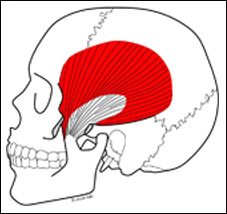This is a series on jaw pain and TMJ. If you missed the beginning, go back to Part 1. To find the temporalis muscle, go back to Self-Treatment: Finding the bony landmarks. The NMT protocol for treatment is in the last two posts. The following self-treatment is from my Neuromuscular Therapy center near Boston.
 The temporalis muscle, as it’s name indicates, attaches to the temporal bone on the side of the head above the ear. It looks similar to a scallop shell with the tendon representing the hinge of the shell. The tendon starts above the zygomatic arch and both muscle and tendon disappear behind it to attach to the coronoid process of the mandible.
The temporalis muscle, as it’s name indicates, attaches to the temporal bone on the side of the head above the ear. It looks similar to a scallop shell with the tendon representing the hinge of the shell. The tendon starts above the zygomatic arch and both muscle and tendon disappear behind it to attach to the coronoid process of the mandible.
The importance of the temporalis muscle to jaw pain is mostly from tension caused by clenching the jaw and grinding the teeth. It’s Trigger Points go mostly into the teeth and side of the head, not into the joint.
Treatment using NMT protocol is effective at the temples (the depression at the outside end of the eyebrows) and on the side of the skull. Pressure and frictioning techniques (side to side across the muscle fibers) all along the top of the zygomatic arch are helpful. You could also use combination friction (up and down and side to side like a cross) all along the side of the head, searching for taut bands of muscle and tender nodules. When you find one, hold pressure until you feel a release.
To treat the tendon attaching to the coronoid process of the mandible, place your fingers side by side under the zygomatic arch with your index fingers at the TM joint in front of your ear. With your pinkie finger you should be able to feel the front edge of the broad slim ramus of the mandible. If you open your jaw as far as you can, you should feel the pointed top of the coronoid process right under the cheekbone. That’s where the temporalis tendon attaches. To treat it, hook your thumb around it and press from the front. You can also use your fingers, but the pressure should be at the front edge of the bone in the angle between the cheekbone and the coronoid. If it is tight, it will be very uncomfortable to treat.
If these major muscles presented in the previous posts don’t address your jaw pain, there are a few others to check. They will be in the next post: digastric, suprahyoid, platysma, buccinator.